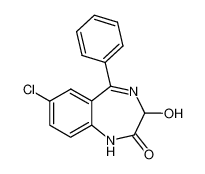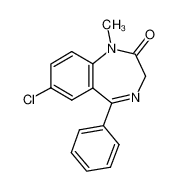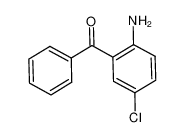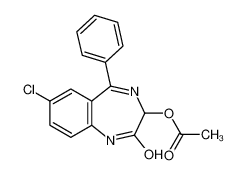1.Identification
1.1 GHS Product identifier
| Product name | oxazepam |
|---|
1.2 Other means of identification
| Product number | - |
|---|---|
| Other names | Serenal |
1.3 Recommended use of the chemical and restrictions on use
| Identified uses | For industry use only. |
|---|---|
| Uses advised against | no data available |
1.4 Supplier's details
| Company | MOLBASE (Shanghai) Biotechnology Co., Ltd. |
|---|---|
| Address | Floor 4 & 5, Building 12, No. 1001 North Qinzhou Road, Xuhui District, Shanghai, China |
| Telephone | +86(21)64956998 |
| Fax | +86(21)54365166 |
1.5 Emergency phone number
| Emergency phone number | +86-400-6021-666 |
|---|---|
| Service hours | Monday to Friday, 9am-5pm (Standard time zone: UTC/GMT +8 hours). |
2.Hazard identification
2.1 Classification of the substance or mixture
Carcinogenicity, Category 2
2.2 GHS label elements, including precautionary statements
| Pictogram(s) |  |
|---|---|
| Signal word | Warning |
| Hazard statement(s) | H351 Suspected of causing cancer |
| Precautionary statement(s) | |
| Prevention | P201 Obtain special instructions before use. P202 Do not handle until all safety precautions have been read and understood. P280 Wear protective gloves/protective clothing/eye protection/face protection. |
| Response | P308+P313 IF exposed or concerned: Get medical advice/ attention. |
| Storage | P405 Store locked up. |
| Disposal | P501 Dispose of contents/container to ... |
2.3 Other hazards which do not result in classification
none
3.Composition/information on ingredients
3.1 Substances
| Chemical name | Common names and synonyms | CAS number | EC number | Concentration |
|---|---|---|---|---|
| oxazepam | oxazepam | 604-75-1 | none | 100% |
4.First-aid measures
4.1 Description of necessary first-aid measures
General advice
Consult a physician. Show this safety data sheet to the doctor in attendance.
If inhaled
If breathed in, move person into fresh air. If not breathing, give artificial respiration. Consult a physician.
In case of skin contact
Wash off with soap and plenty of water. Consult a physician.
In case of eye contact
Rinse thoroughly with plenty of water for at least 15 minutes and consult a physician.
If swallowed
Never give anything by mouth to an unconscious person. Rinse mouth with water. Consult a physician.
4.2 Most important symptoms/effects, acute and delayed
SYMPTOMS: Symptoms of exposure to this compound include sedation, nausea, drowsiness, ataxia and coma (from large doses). Other symptoms include vomiting, lethargy, hyporeflexia, muscular weakness, dysarthria, nystagmus, hypotension, respiratory failure and death from respiratory or cardiac arrest. Exposure can cause syncope, liver damage, bone marrow damage and sensitivity reactions. It can also cause dryness of the mouth, aggressive behavior, blood dyscrasias and hepatic dysfunction. Sleepiness has been reported. It may cause lightheadedness, respiratory depression, constipation, changes in salivation, blurred vision, diplopia, urinary retention, incontinence, mental depression, tremor, headache, confusion, slurred speech, vertigo, changes in libido, blood disorders, jaundice, central nervous system depression and, sometimes, paradoxical reactions such as dysphoria. It may also cause skin rashes (morbilliform, urticarial and maculopapular), dizziness, stimulation of affect, leukopenia, severe rage reactions (rare), menstrual irregularities, change in EEG pattern, agranulocytosis, stupor, disorientation, fever, euphoria, transient amnesia and memory impairment. Exposure to children has resulted in somnolence, changes in REM sleep and loss of muscle control (ataxia). It has also caused lethargy, paradoxical excitation, depressed reflexes, facial edema, delirium, hallucinations and convulsions. ACUTE/CHRONIC HAZARDS: When heated to decomposition this compound emits very toxic fumes of nitrogen oxides and hydrogen chloride.
4.3 Indication of immediate medical attention and special treatment needed, if necessary
Treatment is entirely supportive with IV access and fluids and maintenance of the airway and ventilation if required. Patients with a significant sedative drug overdose should be advised not to drive until potential interference with psychomotor performance has resolved. For significant benzodiazepine overdose, this is at least 24 hours after discharge./Benzodiazepines/
5.Fire-fighting measures
5.1 Extinguishing media
Suitable extinguishing media
Fires involving this material can be controlled with a dry chemical, carbon dioxide or Halon extinguisher.
5.2 Specific hazards arising from the chemical
Flash point data for this chemical are not available; however, it is probably combustible.
5.3 Special protective actions for fire-fighters
Wear self-contained breathing apparatus for firefighting if necessary.
6.Accidental release measures
6.1 Personal precautions, protective equipment and emergency procedures
Use personal protective equipment. Avoid dust formation. Avoid breathing vapours, mist or gas. Ensure adequate ventilation. Evacuate personnel to safe areas. Avoid breathing dust. For personal protection see section 8.
6.2 Environmental precautions
Prevent further leakage or spillage if safe to do so. Do not let product enter drains. Discharge into the environment must be avoided.
6.3 Methods and materials for containment and cleaning up
Pick up and arrange disposal. Sweep up and shovel. Keep in suitable, closed containers for disposal.
7.Handling and storage
7.1 Precautions for safe handling
Avoid contact with skin and eyes. Avoid formation of dust and aerosols. Avoid exposure - obtain special instructions before use.Provide appropriate exhaust ventilation at places where dust is formed. For precautions see section 2.2.
7.2 Conditions for safe storage, including any incompatibilities
Oxazepam capsules and tablets should be stored in well-closed containers at a temperature less than 40°C, preferably at 15-30°C.
8.Exposure controls/personal protection
8.1 Control parameters
Occupational Exposure limit values
no data available
Biological limit values
no data available
8.2 Appropriate engineering controls
Handle in accordance with good industrial hygiene and safety practice. Wash hands before breaks and at the end of workday.
8.3 Individual protection measures, such as personal protective equipment (PPE)
Eye/face protection
Safety glasses with side-shields conforming to EN166. Use equipment for eye protection tested and approved under appropriate government standards such as NIOSH (US) or EN 166(EU).
Skin protection
Wear impervious clothing. The type of protective equipment must be selected according to the concentration and amount of the dangerous substance at the specific workplace. Handle with gloves. Gloves must be inspected prior to use. Use proper glove removal technique(without touching glove's outer surface) to avoid skin contact with this product. Dispose of contaminated gloves after use in accordance with applicable laws and good laboratory practices. Wash and dry hands. The selected protective gloves have to satisfy the specifications of EU Directive 89/686/EEC and the standard EN 374 derived from it.
Respiratory protection
Wear dust mask when handling large quantities.
Thermal hazards
no data available
9.Physical and chemical properties
| Physical state | PHYSICAL DESCRIPTION: Odorless creamy-white to pale-yellow powder or white crystalline solid. Bitter taste. pH (2% aqueous suspension) 4.8-7. |
|---|---|
| Colour | Crystals from alcohol |
| Odour | PRACTICALLY ODORLESS |
| Melting point/ freezing point | 205-206ºC |
| Boiling point or initial boiling point and boiling range | 506.5ºC at 760 mmHg |
| Flammability | no data available |
| Lower and upper explosion limit / flammability limit | no data available |
| Flash point | 11ºC |
| Auto-ignition temperature | no data available |
| Decomposition temperature | no data available |
| pH | BETWEEN 4.8 AND 7.0 (1 IN 50 SUSPENSION) |
| Kinematic viscosity | no data available |
| Solubility | less than 1 mg/mL at 18.89°C |
| Partition coefficient n-octanol/water (log value) | no data available |
| Vapour pressure | 4.2X10-12 mm Hg at 25°C /Estimated/ |
| Density and/or relative density | 1.42g/cm3 |
| Relative vapour density | no data available |
| Particle characteristics | no data available |
10.Stability and reactivity
10.1 Reactivity
no data available
10.2 Chemical stability
STABLE IN LIGHT
10.3 Possibility of hazardous reactions
OXAZEPAM is stable in light and is non hygroscopic. It is stable in neutral solution. This chemical is hydrolyzed by acids and bases.
10.4 Conditions to avoid
no data available
10.5 Incompatible materials
no data available
10.6 Hazardous decomposition products
no data available
11.Toxicological information
Acute toxicity
- Oral: LD50 Rat oral 5 g/kg
- Inhalation: no data available
- Dermal: no data available
Skin corrosion/irritation
no data available
Serious eye damage/irritation
no data available
Respiratory or skin sensitization
no data available
Germ cell mutagenicity
no data available
Carcinogenicity
Evaluation: There is inadequate evidence in humans for the carcinogenicity of oxazepam. There is sufficient evidence in experimental animals for the carcinogenicity of oxazepam. Overall Evaluation: Oxazepam is possibly carcinogenic to humans (Group 2B). In making the overall evaluation, the Working Group took into account that: (1) uncertainty exists regarding the formation of mouse liver tumors by oxazepam as a relevant end point for evaluation of carcinogenic risks to humans. (2) appropriate mechanistic information in humans is lacking.
Reproductive toxicity
no data available
STOT-single exposure
no data available
STOT-repeated exposure
no data available
Aspiration hazard
no data available
12.Ecological information
12.1 Toxicity
- Toxicity to fish: no data available
- Toxicity to daphnia and other aquatic invertebrates: no data available
- Toxicity to algae: no data available
- Toxicity to microorganisms: no data available
12.2 Persistence and degradability
no data available
12.3 Bioaccumulative potential
An estimated BCF of 11 was calculated for oxazepam(SRC), using a log Kow of 2.24(1) and a regression-derived equation(2). According to a classification scheme(3), this BCF suggests the potential for bioconcentration in aquatic organisms is low(SRC).
12.4 Mobility in soil
The Koc of oxazepam is estimated as 390(SRC), using a log Kow of 2.24(1) and a regression-derived equation(2). According to a classification scheme(3), this estimated Koc value suggests that oxazepam is expected to have moderate mobility in soil.
12.5 Other adverse effects
no data available
13.Disposal considerations
13.1 Disposal methods
Product
The material can be disposed of by removal to a licensed chemical destruction plant or by controlled incineration with flue gas scrubbing. Do not contaminate water, foodstuffs, feed or seed by storage or disposal. Do not discharge to sewer systems.
Contaminated packaging
Containers can be triply rinsed (or equivalent) and offered for recycling or reconditioning. Alternatively, the packaging can be punctured to make it unusable for other purposes and then be disposed of in a sanitary landfill. Controlled incineration with flue gas scrubbing is possible for combustible packaging materials.
14.Transport information
14.1 UN Number
| ADR/RID: UN1230 | IMDG: UN1230 | IATA: UN1230 |
14.2 UN Proper Shipping Name
| ADR/RID: METHANOL |
| IMDG: METHANOL |
| IATA: METHANOL |
14.3 Transport hazard class(es)
| ADR/RID: 3 | IMDG: 3 | IATA: 3 |
14.4 Packing group, if applicable
| ADR/RID: II | IMDG: II | IATA: II |
14.5 Environmental hazards
| ADR/RID: no | IMDG: no | IATA: no |
14.6 Special precautions for user
no data available
14.7 Transport in bulk according to Annex II of MARPOL 73/78 and the IBC Code
no data available
15.Regulatory information
15.1 Safety, health and environmental regulations specific for the product in question
| Chemical name | Common names and synonyms | CAS number | EC number |
|---|---|---|---|
| oxazepam | oxazepam | 604-75-1 | none |
| European Inventory of Existing Commercial Chemical Substances (EINECS) | Listed. | ||
| EC Inventory | Listed. | ||
| United States Toxic Substances Control Act (TSCA) Inventory | Not Listed. | ||
| China Catalog of Hazardous chemicals 2015 | Not Listed. | ||
| New Zealand Inventory of Chemicals (NZIoC) | Listed. | ||
| Philippines Inventory of Chemicals and Chemical Substances (PICCS) | Not Listed. | ||
| Vietnam National Chemical Inventory | Not Listed. | ||
| Chinese Chemical Inventory of Existing Chemical Substances (China IECSC) | Listed. | ||
16.Other information
Information on revision
| Creation Date | Aug 18, 2017 |
|---|---|
| Revision Date | Aug 18, 2017 |
Abbreviations and acronyms
- CAS: Chemical Abstracts Service
- ADR: European Agreement concerning the International Carriage of Dangerous Goods by Road
- RID: Regulation concerning the International Carriage of Dangerous Goods by Rail
- IMDG: International Maritime Dangerous Goods
- IATA: International Air Transportation Association
- TWA: Time Weighted Average
- STEL: Short term exposure limit
- LC50: Lethal Concentration 50%
- LD50: Lethal Dose 50%
- EC50: Effective Concentration 50%
References
- IPCS - The International Chemical Safety Cards (ICSC), website: http://www.ilo.org/dyn/icsc/showcard.home
- HSDB - Hazardous Substances Data Bank, website: https://toxnet.nlm.nih.gov/newtoxnet/hsdb.htm
- IARC - International Agency for Research on Cancer, website: http://www.iarc.fr/
- eChemPortal - The Global Portal to Information on Chemical Substances by OECD, website: http://www.echemportal.org/echemportal/index?pageID=0&request_locale=en
- CAMEO Chemicals, website: http://cameochemicals.noaa.gov/search/simple
- ChemIDplus, website: http://chem.sis.nlm.nih.gov/chemidplus/chemidlite.jsp
- ERG - Emergency Response Guidebook by U.S. Department of Transportation, website: http://www.phmsa.dot.gov/hazmat/library/erg
- Germany GESTIS-database on hazard substance, website: http://www.dguv.de/ifa/gestis/gestis-stoffdatenbank/index-2.jsp
- ECHA - European Chemicals Agency, website: https://echa.europa.eu/

















